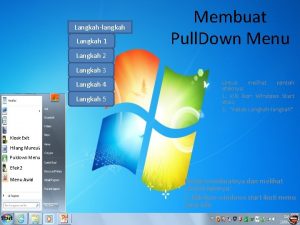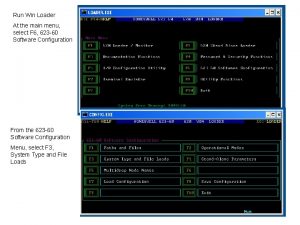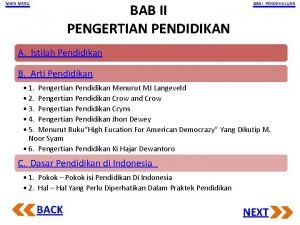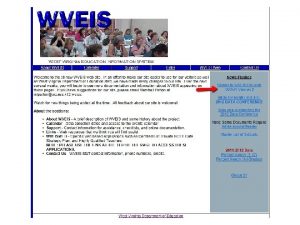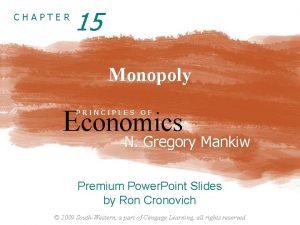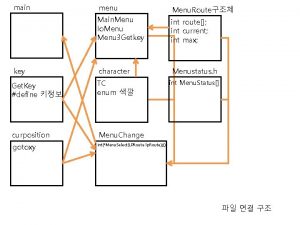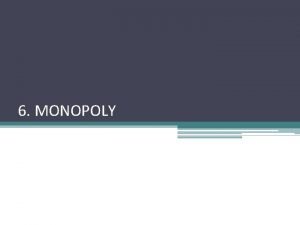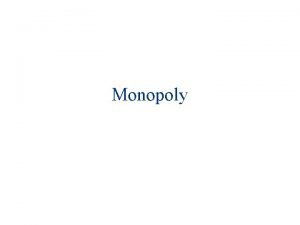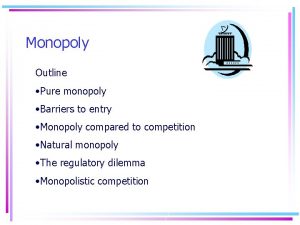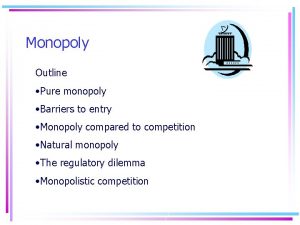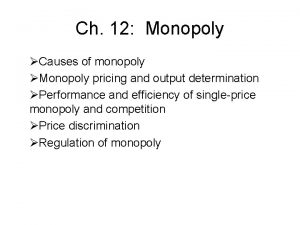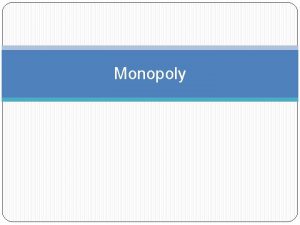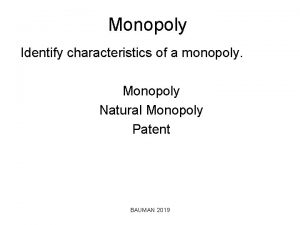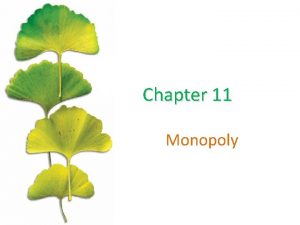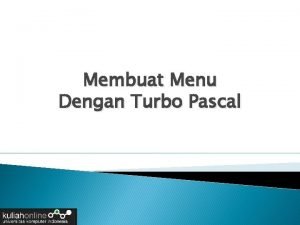MONOPOLY Chapter 9 Section Main Menu Defining Monopoly
























- Slides: 24

MONOPOLY Chapter 9 Section Main Menu

Defining Monopoly • A monopoly is a market dominated by a single seller. • Monopolies form when barriers prevent firms from entering a market that has a single supplier. • Monopolies can take advantage of their monopoly power and charge high prices. Chapter 9 Section Main Menu

Forming a Monopoly Different market conditions can create different types of monopolies. 1. Economies of Scale If a firm's start-up costs are high, and its average costs fall for each additional unit it produces, then it enjoys what economists call economies of scale. An industry that enjoys economies of scale can easily become a natural monopoly. 2. Natural Monopolies A natural monopoly is a market that runs most efficiently when one large firm provides all of the output. 3. Technology and Change Sometimes the development of a new technology can destroy a natural monopoly. Chapter 9 Section Main Menu

Government Monopolies A government monopoly is a monopoly created by the government. • Technological Monopolies – The government grants patents, licenses that give the inventor of a new product the exclusive right to sell it for a certain period of time. • Franchises and Licenses – A franchise is a contract that gives a single firm the right to sell its goods within an exclusive market. A license is a government-issued right to operate a business. • Industrial Organizations – In rare cases, such as sports leagues, the government allows companies in an industry to restrict the number of firms in the market. Chapter 9 Section Main Menu

Price Discrimination Price discrimination is the division of customers into groups based on how much they will pay for a good. • Although price discrimination is a feature of monopoly, it can be practiced by any company with market power. Market power is the ability to control prices and total market output. Chapter 9 Section • Targeted discounts, like student discounts and manufacturers’ rebate offers, are one form of price discrimination. • Price discrimination requires some market power, distinct customer groups, and difficult resale. Main Menu

Output Decisions • Monopolists will try to maximize profits; therefore, compared with a perfectly competitive market, the monopolist produces fewer goods at a higher price. A monopolist sets output at a point where marginal revenue is equal to marginal cost. Setting a Price in a Monopoly Market Price $11 Marginal Cost B C Price • Even a monopolist faces a limited choice – it can choose to set either output or price, but not both. Demand $3 A 9, 000 Output (in doses) Chapter 9 Section Main Menu Marginal Revenue

Market Power Market power is the ability of a company to control prices and output. • Markets dominated by a few large firms tend to have higher prices and lower output than markets with many sellers. Chapter 9 Section • To control prices and output like a monopoly, firms sometimes use predatory pricing. Predatory pricing sets the market price below cost levels for the short term to drive out competitors. Main Menu

Government and Competition Government policies keep firms from controlling the prices and supply of important goods. Antitrust laws are laws that encourage competition in the marketplace. 1. Regulating Business Practices The government has the power to regulate business practices if these practices give too much power to a company that already has few competitors. 3. Blocking Mergers A merger is a combination of two or more companies into a single firm. The government can block mergers that would decrease competition. 2. Breaking Up Monopolies The government has used antitrust legislation to break up existing monopolies, such as the Standard Oil Trust and AT&T. 4. Preserving Incentives In 1997, new guidelines were introduced for proposed mergers, giving companies an opportunity to show that their merging benefits consumers. Chapter 9 Section Main Menu

Deregulation is the removal of some government controls over a market. • Deregulation is used to promote competition. • Many new competitors enter a market that has been deregulated. This is followed by an economically healthy weeding out of some firms from that market, which can be hard on workers in the short term. Chapter 9 Section Main Menu

LABOR Chapter 9 Section Main Menu

The United States Labor Force Economics define the labor force as all nonmilitary people who are employed or unemployed. Employment Unemployment • • People are considered unemployed if they are 16 years or older and meet the following criteria: • They do not have a job; and People are considered employed if they are 16 years or older and meet at least one of the following requirements: • They worked a least one hour for pay within the last week; or • They have actively looked for work in the prior 4 weeks; and • They worked 15 or more hours without pay in a family business; or • They are currently available for work. • The held jobs but did not work due to illness, vacations, labor disputes, or bad weather. Chapter 9 Section Main Menu

Occupational Trends A Changing Economy Fewer Goods, More Services • The economy of the United States has transformed from a mainly agricultural economy in the 1800 s, to an industrial giant in the 1900 s. • Overall, the United States is shifting from a manufacturing economy to a service economy. • The computer chip has revolutionized the economy since its introduction in the late 1900 s. Chapter 9 Section • As service jobs increase, the nation is losing manufacturing jobs. • Demand for skilled labor is rising, and the supply of skilled workers is increasing to meet the demand. Main Menu

The Changing Labor Force College Graduates at Work Women at Work • The learning effect is theory that education increases productivity and results in higher wages. • Overall, the number of women in the work force has increased from about 38 percent of all women in 1960 to about 58 percent of all women in 1995. • The screening effect theory suggests that the completion of college indicates to employers that a job applicant is intelligent and hard-working. Chapter 9 Section Main Menu

Education and Income • Potential earnings increase with increased educational attainment. Chapter 9 Section Main Menu

Temporary Employment Contingent employment is temporary or part-time employment. Temporary employees offer firms some of the following benefits: 1. Flexible work arrangements. 2. Easy discharge due to the lack of severance pay for temporary workers. 3. Temporary workers are often paid less and receive fewer benefits than their full-time counterparts. 4. Some employees prefer temporary arrangements. Chapter 9 Section Main Menu

Trends in Wages and Benefits Earnings Up for Some, Down for Others • Earnings for college graduates have increased, while earnings for workers without college degrees have decreased. • Average weekly earnings in the United States decreased from $275 in 1980 to $271 in 1999, as measured in inflation-adjusted dollars. Cost of Benefits Rises • Benefits now make up about 28 percent of total compensation in the economy. • For employers, rising benefits costs raise the cost of doing business and decrease profits. Many firms are turning to contingent employment to curb benefits costs. Chapter 9 Section Main Menu

Supply and Demand in the Labor Market Labor Demand • The higher the wage rate, the smaller the quantity of labor demanded by firms and government. Labor Supply • As wages increase, the quantity of labor supplied also increases. Equilibrium Wage • The wage rate that produces neither an excess supply of workers nor an excess demand for workers in the labor market is called the equilibrium wage. Chapter 9 Section Effects of Wage Increases Main Menu A new restaurant opens in town, offering higher wages for cooks. Other restaurants must raise wages for cooks in order to compete for scarce labor. Restaurants increase the price of meals to cover their increased labor costs. When the price of meals increases, consumer demand decreases. As business decreases, restaurants’ demand for cooks decreases.

Wages and Skill Levels • Wages vary according to workers’ skill levels and education. Jobs are often categorized into the following four groups: Unskilled Labor • Unskilled labor requires no specialized skills, education, or training. Examples: waiters, messengers, janitors Semi-Skilled Labor • Semi-skilled labor requires minimal specialized skills and education. Example: fork-lift operator Chapter 9 Section Skilled Labor • Skilled labor requires specialized skills and training. Examples: auto mechanics, plumbers Professional Labor • Professional labor demands advanced skills and education. Examples: lawyers, doctors, teachers Main Menu

Wage Discrimination Laws Against Wage Discrimination • The Equal Pay Act of 1963 declared that male and female employees in the same workplace performing the same job had to receive the same pay. • Title VII of the Civil Rights Act of 1964 forbids job discrimination on the basis of race, sex, color, religion, or nationality. Pay Levels for Women • Despite these protections, American women today earn about 75 percent of what men earn. Pay Levels for Minorities • As the figure to the right shows, racial minorities tend to earn lower pay than white men. Chapter 9 Section Main Menu

Occupational Trends A labor union is an organization of workers that tries to improve working conditions, wages, and benefits for its members. • Less than 14 percent of U. S. workers belong to a labor union. Chapter 9 Section Main Menu

Labor Force Trends • The union movement took shape over the course of more than a century. Key Events in the U. S. Labor Movement Year • The 1935 National Labor Relations Act, also known as the Wagner Act, gave workers the right to organize and required companies to bargain in good faith with unions. Chapter 9 Section Event 1869 Knights of Labor founded 1911 Fire in the Triangle Shirtwaist Factory in New York kills 146, spurring action on workplace safety 1932 Norris-La Guardia Act outlaws “yellow dog” contracts, gives other protection to unions 1935 Wagner Act gives workers rights to organize 1938 AFL splinter group becomes the independent Congress of Industrial Organizations (CIO), headed by John L. Lewis 1955 AFL and CIO merge to create AFL-CIO 1970 s Rise in anti-union measures by employers 1990 s Increase in public-sector unions, including teaching assistants at some universities Main Menu

Declines in Union Membership • Several factors have led to declines in union membership since the 1950 s: “Right to Work” Laws • The Taft-Harlety Act (1947) allowed states to pass right-to-work laws. These laws ban mandatory union membership at the workplace. Economic Trends • Unions have traditionally been strongest in the manufacturing sector, representing blue-collar workers, or workers who have industrial jobs. Blue-collar jobs have been declining in number as the American economy becomes more service-oriented. Fulfillment of Union Goals • With the government setting standards for workplace safety, and with more benefits being provided by both private and government sources, some claim that the union membership has decreased simply because their goals have been fulfilled by other organizations. Chapter 9 Section Main Menu

Collective Bargaining Collective bargaining is the process in which union and company representatives meet to negotiate a new labor contract. Wages and Benefits • The Union negotiates on behalf of all members for wage rate, overtime rates, planned raises, and benefits. Working Conditions • Safety, comfort, worker responsibilities, and other workplace issues are negotiated and written into the final contract. Job Security • One of the union’s primary goals is to secure its members’ jobs. The contract spells out the conditions under which a worker may be fired. Chapter 9 Section Main Menu

Labor Strikes and Settlements Strikes • If no agreement is met between the union and the company, the union may ask its members to vote on a strike. A strike is an organized work stoppage intended to force an employer to address union demands. Strikes can be harmful to both the union and the firm. Mediation • To avoid the economic losses of a strike, a third party is sometimes called in to settle the dispute. Mediation is a settlement technique in which a neutral mediator meets with each side to try and find an acceptable solution that both sides will accept. Arbitration • If mediation fails, talks may go into arbitration, a settlement technique in which a third party reviews the case and imposes a decision that is legally binding for both sides. Chapter 9 Section Main Menu
 Examples of non defining clauses
Examples of non defining clauses Relative clauses defining and non defining
Relative clauses defining and non defining Prepositions in relative clauses
Prepositions in relative clauses Defining and non defining relative clauses in telugu
Defining and non defining relative clauses in telugu Where kullanımı relative clauses
Where kullanımı relative clauses Defining or non defining relative clause
Defining or non defining relative clause The structure of the atom section 2 defining the atom
The structure of the atom section 2 defining the atom Contoh siklus menu 5 hari
Contoh siklus menu 5 hari Fungsi menu dan ikon pada microsoft excel
Fungsi menu dan ikon pada microsoft excel Cyclical menu
Cyclical menu Ikon mozilla
Ikon mozilla Menu pull down
Menu pull down Healthy main course meal
Healthy main course meal Win loader
Win loader Main menu
Main menu ? main menu
? main menu Front and main menu
Front and main menu Arti back to main menu
Arti back to main menu Eway bill system
Eway bill system Wow change login screen
Wow change login screen Chapter 10 section 1 meiosis worksheet answer key
Chapter 10 section 1 meiosis worksheet answer key Form of will future
Form of will future Stated main idea and implied main idea
Stated main idea and implied main idea Void main int main
Void main int main Mankiw chapter 15 solutions
Mankiw chapter 15 solutions











